door lock LEXUS LS500H 2020 Owners Manual
[x] Cancel search | Manufacturer: LEXUS, Model Year: 2020, Model line: LS500H, Model: LEXUS LS500H 2020Pages: 516, PDF Size: 10.38 MB
Page 2 of 516
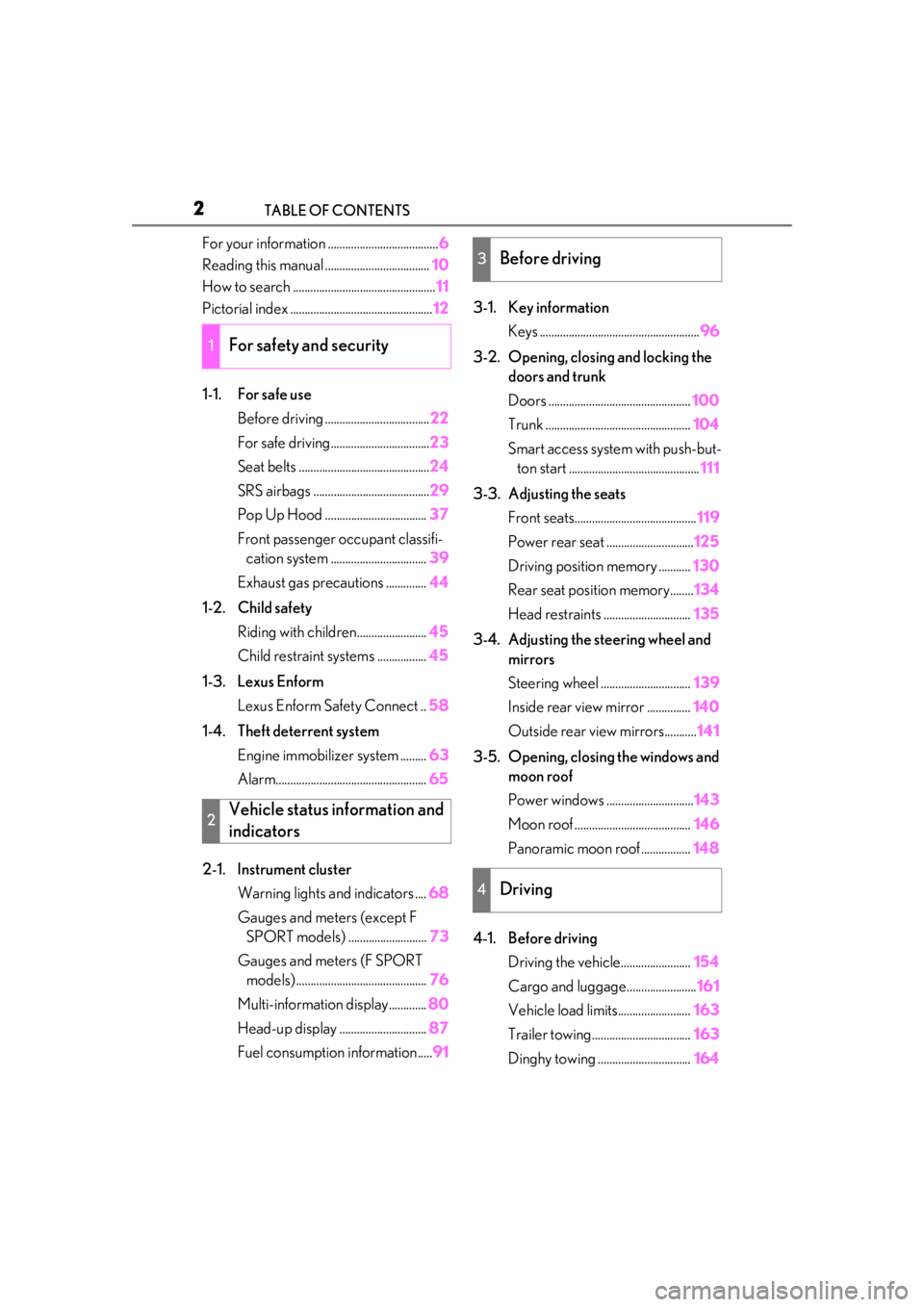
2TABLE OF CONTENTS
For your information ......................................6
Reading this manual .................................... 10
How to search ................................................. 11
Pictorial index ................................................. 12
1-1. For safe use Before driving .................................... 22
For safe driving.................................. 23
Seat belts ............................................. 24
SRS airbags ........................................ 29
Pop Up Hood ................................... 37
Front passenger occupant classifi- cation system ................................. 39
Exhaust gas precautions .............. 44
1-2. Child safety Riding with children........................ 45
Child restraint systems ................. 45
1-3. Lexus Enform Lexus Enform Safety Connect .. 58
1-4. Theft deterrent system Engine immobilizer system ......... 63
Alarm.................................................... 65
2-1. Instrument cluster Warning lights and indicators .... 68
Gauges and meters (except F SPORT models) ........................... 73
Gauges and meters (F SPORT models) ............................................. 76
Multi-information display............. 80
Head-up display .............................. 87
Fuel consumption information ..... 913-1. Key information
Keys ....................................................... 96
3-2. Opening, closing and locking the doors and trunk
Doors ................................................. 100
Trunk .................................................. 104
Smart access system with push-but- ton start ............................................. 111
3-3. Adjusting the seats Front seats.......................................... 119
Power rear seat .............................. 125
Driving position memory ........... 130
Rear seat position memory........ 134
Head restraints .............................. 135
3-4. Adjusting the steering wheel and mirrors
Steering wheel ............................... 139
Inside rear view mirror ............... 140
Outside rear view mirrors........... 141
3-5. Opening, closing the windows and moon roof
Power windows .............................. 143
Moon roof ........................................ 146
Panoramic moon roof ................. 148
4-1. Before driving Driving the vehicle........................ 154
Cargo and luggage........................ 161
Vehicle load limits......................... 163
Trailer towing.................................. 163
Dinghy towing ................................ 164
1For safety and security
2Vehicle status information and
indicators
3Before driving
4Driving
Page 12 of 516

12Pictorial index
Pictorial index
■Exterior
Doors .......................................................................................................................... P.100
Locking/unlocking ............................................................................................................ P. 100
Opening/closing the side windows ........................................................................... P.143
Locking/unlocking by using th e mechanical key ................................................ P.437
Warning lights/warning messages ................................................................. P.419, 429
Trunk .......................................................................................................................... .P.104
Opening from inside the cabin .................................................................................... P.106
Opening from outside ..................................................................................................... P.107
Opening by using the mechanical key .................................................................... P.437
Warning lights/warning messages ................................................................. P.419, 429
Outside rear view mirrors..................................................................................... P.141
Adjusting the mirror angle ............................................................................................... P.141
Folding the mirrors ............................................................................................................ .P.142
Driving position memory ................................................................................................ P.130
Defogging the mirrors ......................................................................................................P.31 7
Windshield wipers ..................................................................................................P.185A
B
C
D
Page 17 of 516
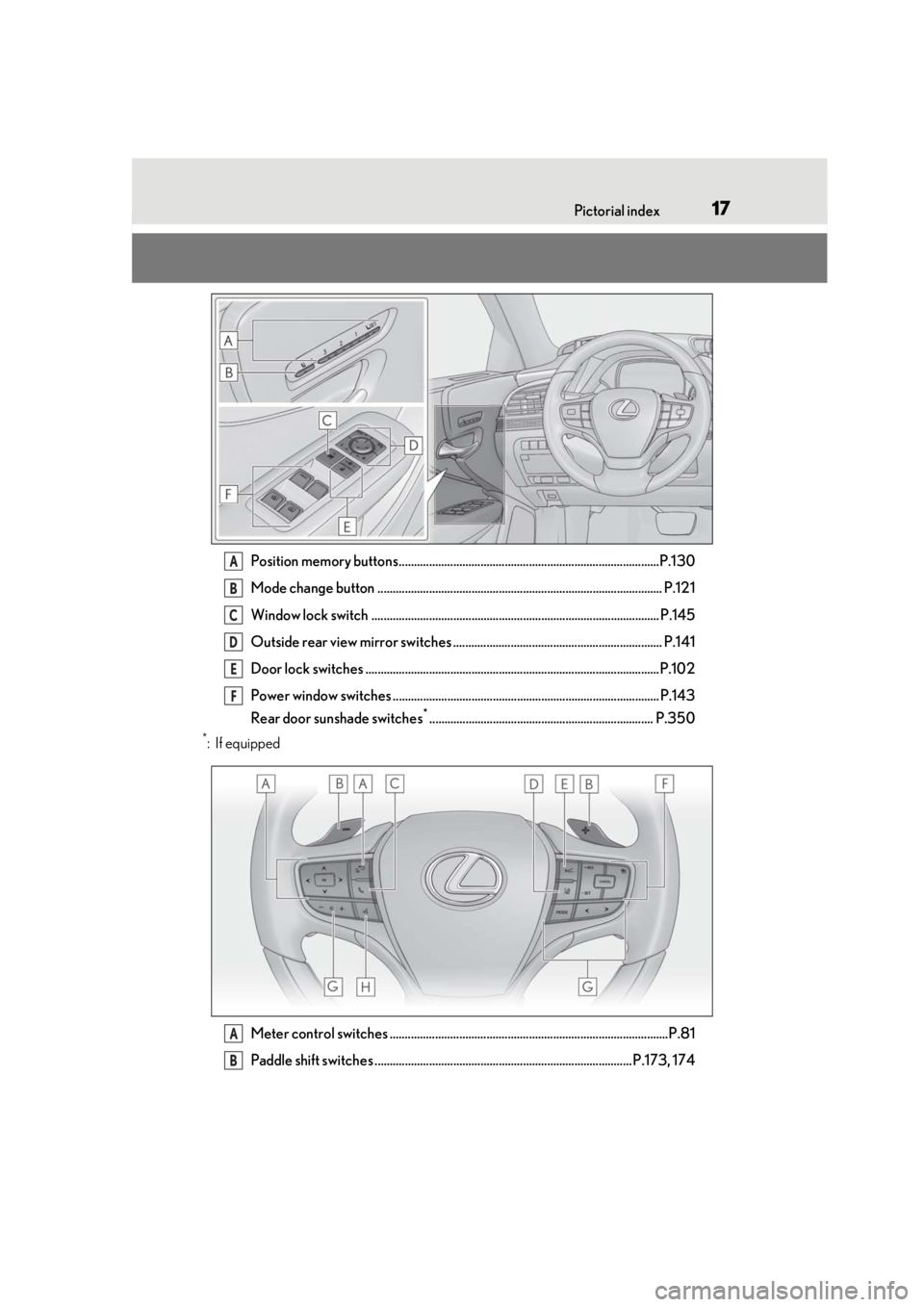
17Pictorial index
Position memory buttons......................................................................................P.130
Mode change button .............................................................................................. P.121
Window lock switch ............................................................................................... P.145
Outside rear view mirror switches ..................................................................... P.141
Door lock switches .................................................................................................P.102
Power window switches ........................................................................................ P.143
Rear door sunshade switches
*.......................................................................... P.350
*:If equippedMeter control switches ............................................................................................P.81
Paddle shift switches ..................................................................................... P.173, 174
A
B
C
D
E
F
A
B
Page 26 of 516
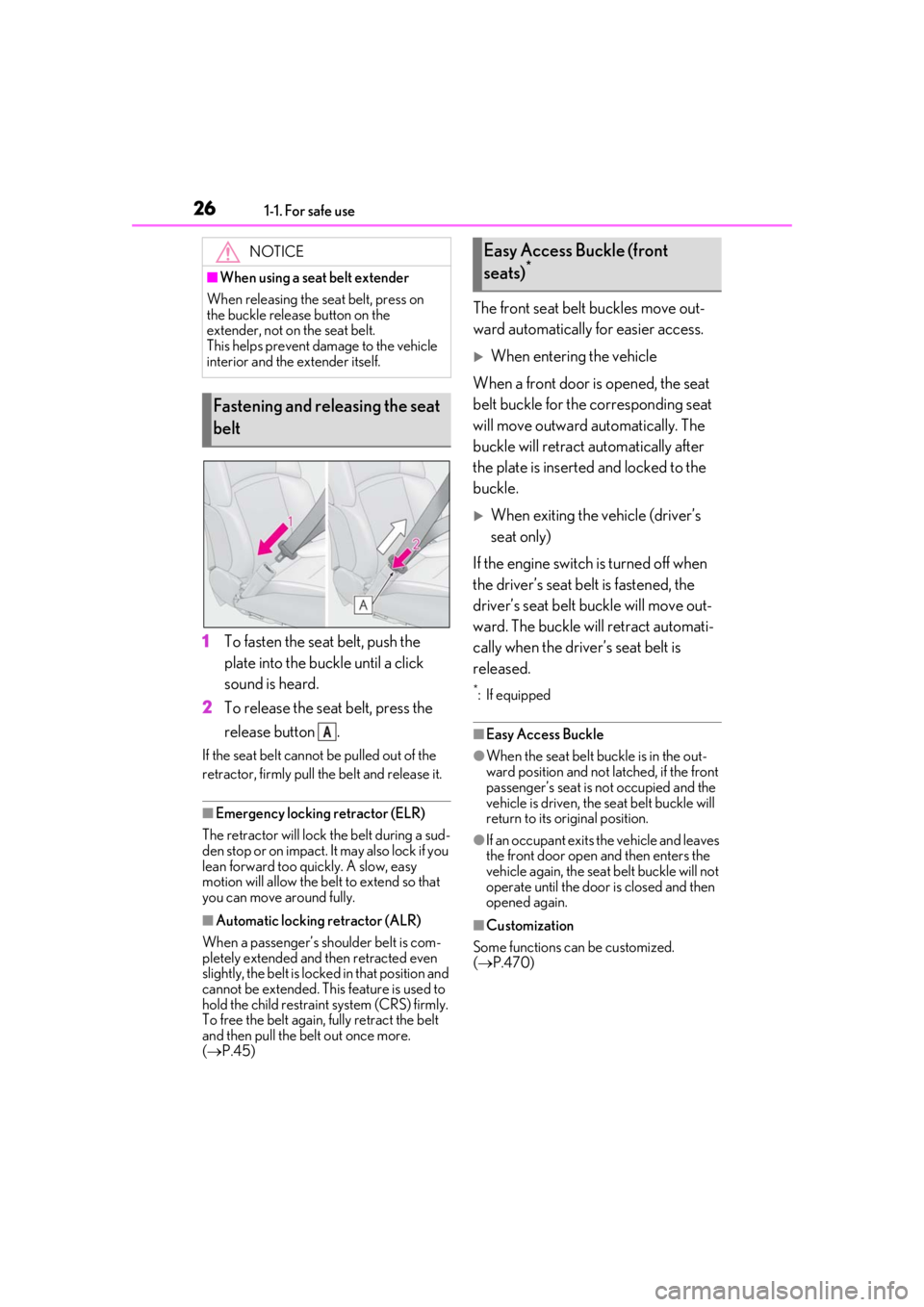
261-1. For safe use
1To fasten the seat belt, push the
plate into the buckle until a click
sound is heard.
2
To release the seat belt, press the
release button .
If the seat belt cannot be pulled out of the
retractor, firmly pull the belt and release it.
■Emergency locking retractor (ELR)
The retractor will lock the belt during a sud-
den stop or on impact. It may also lock if you
lean forward too quickly. A slow, easy
motion will allow the belt to extend so that
you can move around fully.
■Automatic locking retractor (ALR)
When a passenger’s sh oulder belt is com-
pletely extended and then retracted even
slightly, the belt is locked in that position and
cannot be extended. This feature is used to
hold the child restraint system (CRS) firmly.
To free the belt again, fully retract the belt
and then pull the belt out once more.
( P.45)
The front seat belt buckles move out-
ward automatically for easier access.
When entering the vehicle
When a front door is opened, the seat
belt buckle for the corresponding seat
will move outward automatically. The
buckle will retract automatically after
the plate is inserted and locked to the
buckle.
When exiting the vehicle (driver’s
seat only)
If the engine switch is turned off when
the driver’s seat belt is fastened, the
driver’s seat belt buckle will move out-
ward. The buckle will retract automati-
cally when the driver’s seat belt is
released.
*: If equipped
■Easy Access Buckle
●When the seat belt buckle is in the out-
ward position and not latched, if the front
passenger’s seat is not occupied and the
vehicle is driven, the seat belt buckle will
return to its original position.
●If an occupant exits the vehicle and leaves
the front door open and then enters the
vehicle again, the seat belt buckle will not
operate until the door is closed and then
opened again.
■Customization
Some functions can be customized.
( P.470)
NOTICE
■When using a seat belt extender
When releasing the se at belt, press on
the buckle release button on the
extender, not on the seat belt.
This helps prevent damage to the vehicle
interior and the extender itself.
Fastening and releasing the seat
belt
A
Easy Access Buckle (front
seats)*
Page 31 of 516
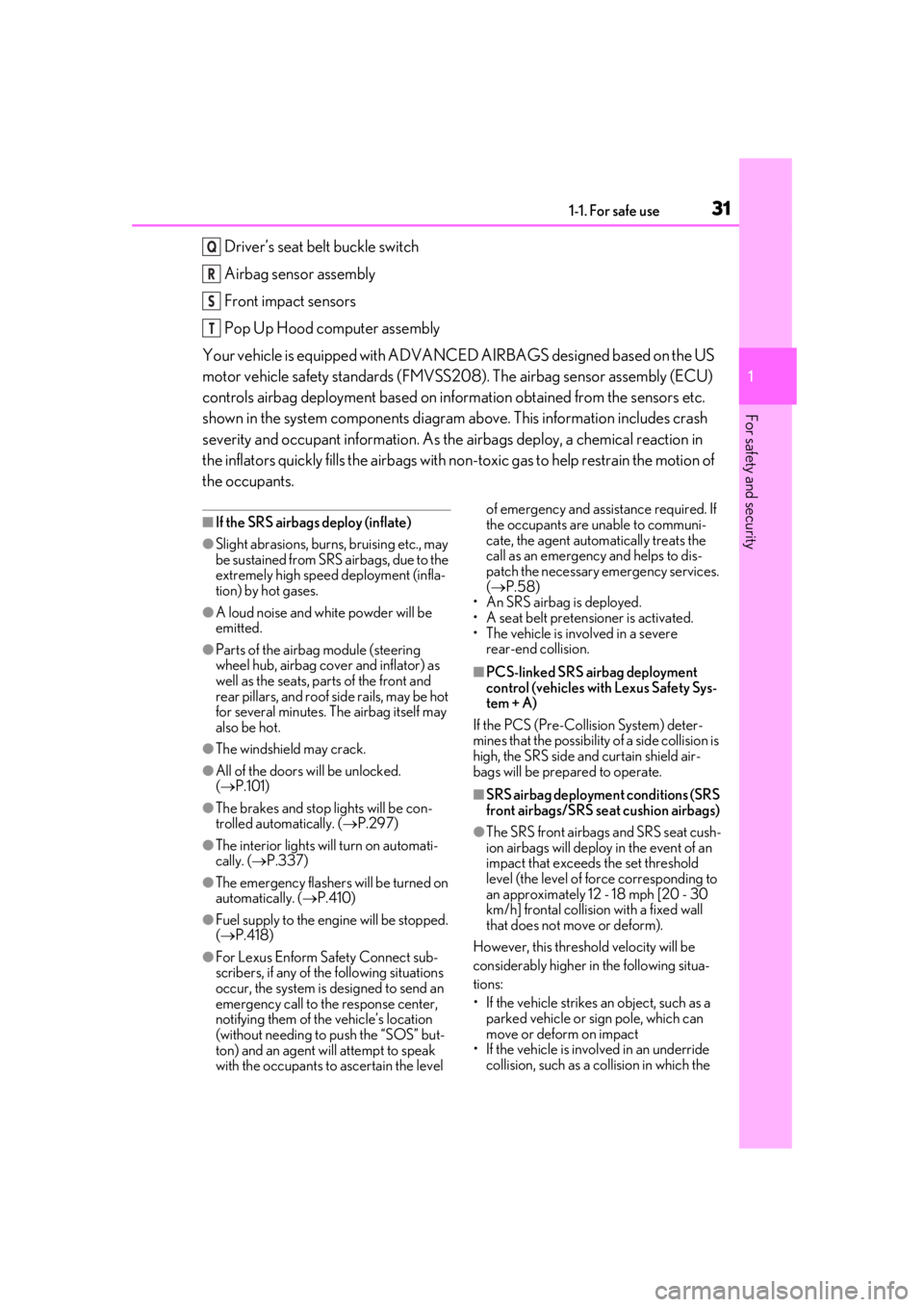
311-1. For safe use
1
For safety and security
Driver’s seat belt buckle switch
Airbag sensor assembly
Front impact sensors
Pop Up Hood computer assembly
Your vehicle is equipped with ADVANCED AIRBAGS designed based on the US
motor vehicle safety standards (FMVSS208). The airbag sensor assembly (ECU)
controls airbag deployment based on information obtained from the sensors etc.
shown in the system components diagram above. This information includes crash
severity and occupant information. As the airbags deploy, a chemical reaction in
the inflators quickly fills the airbags with no n-toxic gas to help restrain the motion of
the occupants.
■If the SRS airbags deploy (inflate)
●Slight abrasions, burns, bruising etc., may
be sustained from SRS airbags, due to the
extremely high speed deployment (infla-
tion) by hot gases.
●A loud noise and white powder will be
emitted.
●Parts of the airbag module (steering
wheel hub, airbag cover and inflator) as
well as the seats, parts of the front and
rear pillars, and roof side rails, may be hot
for several minutes. The airbag itself may
also be hot.
●The windshield may crack.
●All of the doors will be unlocked.
( P.101)
●The brakes and stop lights will be con-
trolled automatically. ( P.297)
●The interior lights will turn on automati-
cally. ( P.337)
●The emergency flashers will be turned on
automatically. ( P.410)
●Fuel supply to the engine will be stopped.
( P.418)
●For Lexus Enform Safety Connect sub-
scribers, if any of the following situations
occur, the system is designed to send an
emergency call to the response center,
notifying them of the vehicle’s location
(without needing to push the “SOS” but-
ton) and an agent will attempt to speak
with the occupants to ascertain the level of emergency and assistance required. If
the occupants are unable to communi-
cate, the agent automatically treats the
call as an emergency and helps to dis-
patch the necessary emergency services.
(
P.58)
• An SRS airbag is deployed.
• A seat belt pretensioner is activated.
• The vehicle is involved in a severe rear-end collision.
■PCS-linked SRS airbag deployment
control (vehicles with Lexus Safety Sys-
tem + A)
If the PCS (Pre-Collision System) deter-
mines that the possibility of a side collision is
high, the SRS side and curtain shield air-
bags will be prepared to operate.
■SRS airbag deployment conditions (SRS
front airbags/SRS seat cushion airbags)
●The SRS front airbags and SRS seat cush-
ion airbags will deploy in the event of an
impact that exceed s the set threshold
level (the level of fo rce corresponding to
an approximately 12 - 18 mph [20 - 30
km/h] frontal collision with a fixed wall
that does not move or deform).
However, this threshol d velocity will be
considerably higher in the following situa-
tions:
• If the vehicle strikes an object, such as a parked vehicle or sign pole, which can
move or deform on impact
• If the vehicle is involved in an underride
collision, such as a collision in which the
Q
R
S
T
Page 45 of 516

451-2. Child safety
1
For safety and security
1-2.Child safety
Points to remember: P.45
Child restraint system: P.46
When using a child restraint system:
P.47
Child restraint system installation
method
• Fixed with a seat belt: P.49
• Fixed with a child restraint LATCH anchor: P.53
• Using an anchor bracket (for top tether strap): P.55
The laws of all 50 states of the U.S.A.
as well as Canada now require the use
of child restraint systems.
Prioritize and observe the warn-
ings, as well as the laws and regula-
Riding with children
Observe the following precautions
when children are in the vehicle.
Use a child restraint system appro-
priate for the child , until the child
becomes large enough to properly
wear the vehicle’s seat belt.
It is recommended that children
sit in the rear seats to avoid acci-
dental contact with the shift lever,
wiper switch etc.
Use the rear door child-protector
lock or the window lock switch to
avoid children opening the door
while driving or operating the
power window accidentally.
( P.103, 145)
Do not let small children operate
equipment which may catch or
pinch body parts, such as the
power window, hood, trunk, seats
etc.
WARNING
■When children are in the vehicle
Never leave children unattended in the
vehicle, and never allow children to have
or use the key.
Children may be able to start the vehicle
or shift the vehicle into neutral. There is
also a danger that children may injure
themselves by playing with the windows,
the moon roof or panoramic moon roof,
or other features of the vehicle. In addi-
tion, heat build-up or extremely cold
temperatures inside the vehicle can be
fatal to children.
Child restraint systems
Before installing a child restraint
system in the vehicle, there are pre-
cautions that need to be observed,
different types of child restraint sys-
tems, as well as installation meth-
ods, etc., written in this manual.
Use a child restraint system when
riding with a small child that cannot
properly use a seat belt. For the
child’s safety, install the child restraint
system to a rear seat. Be sure to fol-
low the installation method that is in
the operation manual enclosed with
the restraint system.
Table of contents
Points to remember
Page 49 of 516
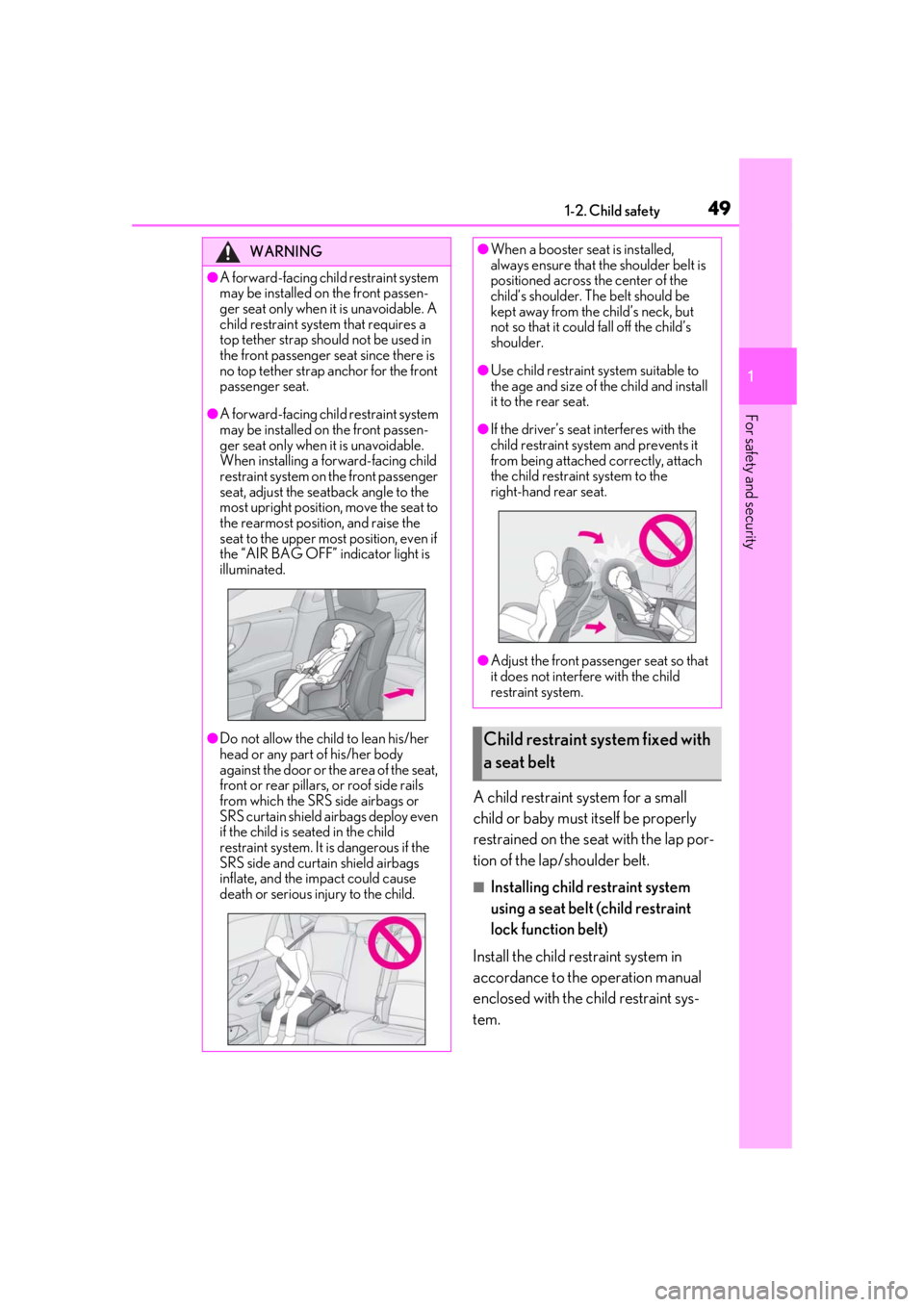
491-2. Child safety
1
For safety and security
A child restraint system for a small
child or baby must itself be properly
restrained on the seat with the lap por-
tion of the lap/shoulder belt.
■Installing child restraint system
using a seat belt (child restraint
lock function belt)
Install the child restraint system in
accordance to the operation manual
enclosed with the child restraint sys-
tem.
WARNING
●A forward-facing child restraint system
may be installed on the front passen-
ger seat only when it is unavoidable. A
child restraint system that requires a
top tether strap should not be used in
the front passenger seat since there is
no top tether strap anchor for the front
passenger seat.
●A forward-facing child restraint system
may be installed on the front passen-
ger seat only when it is unavoidable.
When installing a forward-facing child
restraint system on the front passenger
seat, adjust the seatback angle to the
most upright position, move the seat to
the rearmost position, and raise the
seat to the upper most position, even if
the “AIR BAG OFF” indicator light is
illuminated.
●Do not allow the child to lean his/her
head or any part of his/her body
against the door or the area of the seat,
front or rear pillars, or roof side rails
from which the SRS side airbags or
SRS curtain shield ai rbags deploy even
if the child is seated in the child
restraint system. It is dangerous if the
SRS side and curtain shield airbags
inflate, and the impact could cause
death or serious injury to the child.
●When a booster seat is installed,
always ensure that th e shoulder belt is
positioned across the center of the
child’s shoulder. The belt should be
kept away from the child’s neck, but
not so that it could fall off the child’s
shoulder.
●Use child restraint system suitable to
the age and size of the child and install
it to the rear seat.
●If the driver’s seat interferes with the
child restraint system and prevents it
from being attached correctly, attach
the child restraint system to the
right-hand rear seat.
●Adjust the front passe nger seat so that
it does not interfere with the child
restraint system.
Child restraint system fixed with
a seat belt
Page 65 of 516
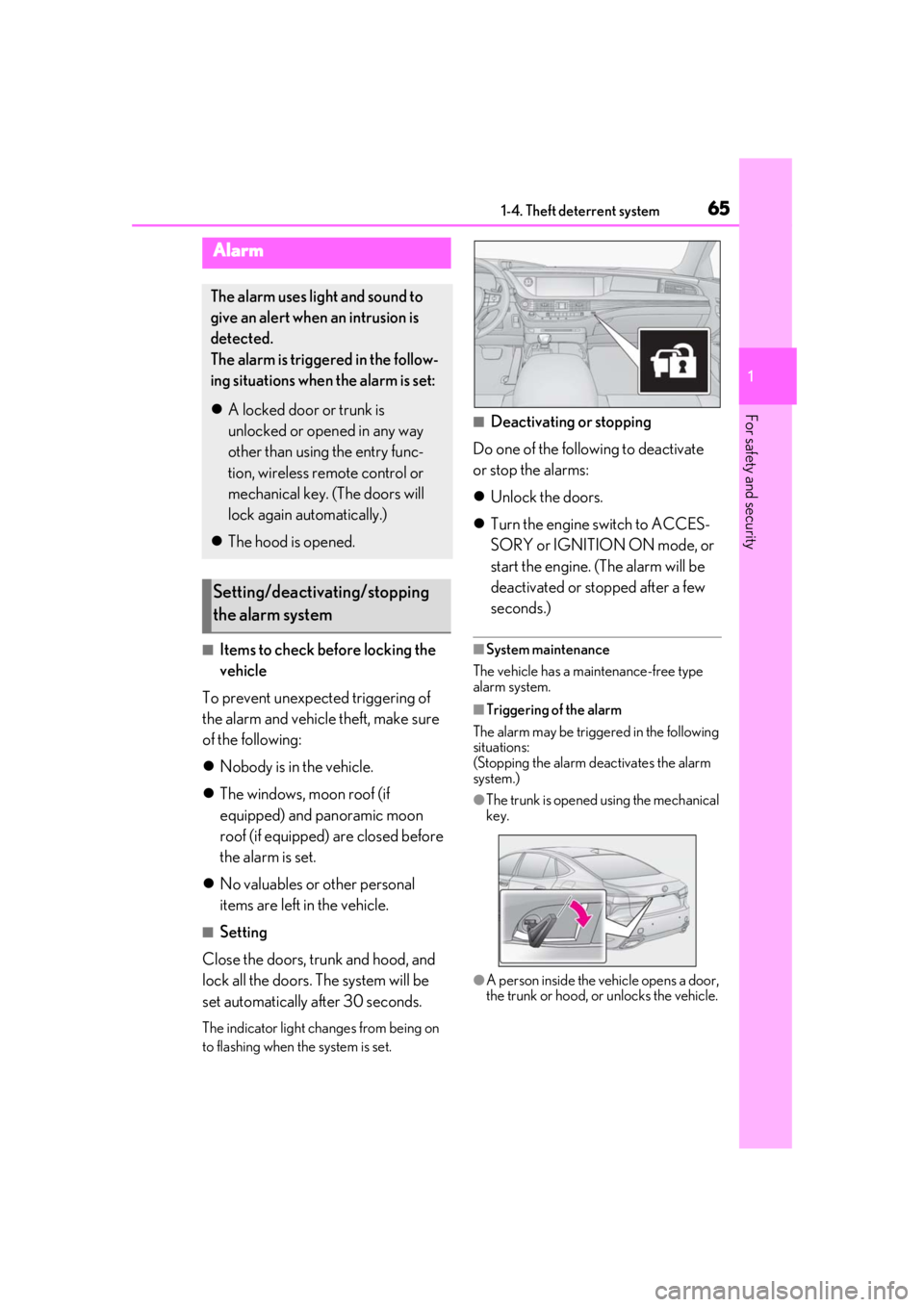
651-4. Theft deterrent system
1
For safety and security
■Items to check before locking the
vehicle
To prevent unexpected triggering of
the alarm and vehicle theft, make sure
of the following:
Nobody is in the vehicle.
The windows, moon roof (if
equipped) and panoramic moon
roof (if equipped) are closed before
the alarm is set.
No valuables or other personal
items are left in the vehicle.
■Setting
Close the doors, trunk and hood, and
lock all the doors. The system will be
set automatically after 30 seconds.
The indicator light changes from being on
to flashing when the system is set.
■Deactivating or stopping
Do one of the following to deactivate
or stop the alarms:
Unlock the doors.
Turn the engine switch to ACCES-
SORY or IGNITION ON mode, or
start the engine. (The alarm will be
deactivated or stopped after a few
seconds.)
■System maintenance
The vehicle has a maintenance-free type
alarm system.
■Triggering of the alarm
The alarm may be triggered in the following
situations:
(Stopping the alarm deactivates the alarm
system.)
●The trunk is opened using the mechanical
key.
●A person inside the vehicle opens a door,
the trunk or hood, or unlocks the vehicle.
Alarm
The alarm uses light and sound to
give an alert when an intrusion is
detected.
The alarm is triggered in the follow-
ing situations when the alarm is set:
A locked door or trunk is
unlocked or opened in any way
other than using the entry func-
tion, wireless remote control or
mechanical key. (The doors will
lock again automatically.)
The hood is opened.
Setting/deactivating/stopping
the alarm system
Page 66 of 516
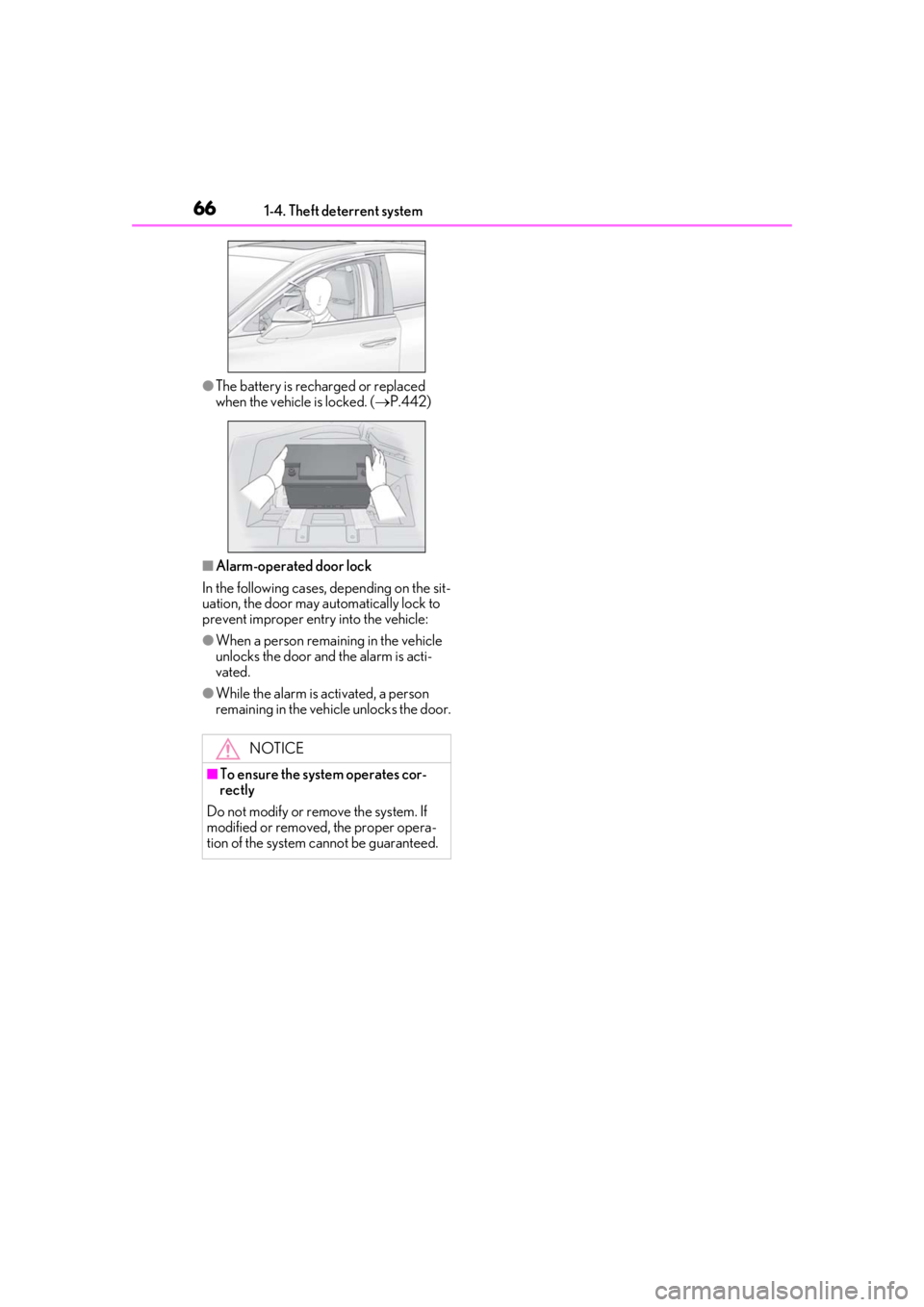
661-4. Theft deterrent system
●The battery is recharged or replaced
when the vehicle is locked. ( P.442)
■Alarm-operated door lock
In the following cases, depending on the sit-
uation, the door may automatically lock to
prevent improper entry into the vehicle:
●When a person remaining in the vehicle
unlocks the door and the alarm is acti-
vated.
●While the alarm is activated, a person
remaining in the vehicle unlocks the door.
NOTICE
■To ensure the system operates cor-
rectly
Do not modify or remove the system. If
modified or removed, the proper opera-
tion of the system cannot be guaranteed.
Page 95 of 516

95
3
3
Before driving
Before driving
.3-1. Key informationKeys ................................................... 96
3-2. Opening, closing and locking the doors and trunk
Doors............................................... 100
Trunk................................................ 104
Smart access system with push-button start ....................... 111
3-3. Adjusting the seats Front seats ...................................... 119
Power rear seat........................... 125
Driving position memory ........ 130
Rear seat position memory .... 134
Head restraints............................ 135
3-4. Adjusting the steering wheel and mirrors
Steering wheel............................. 139
Inside rear view mirror............. 140
Outside rear view mirrors ....... 141
3-5. Opening, closing the windows and moon roof
Power windows........................... 143
Moon roof ..................................... 146
Panoramic moon roof .............. 148